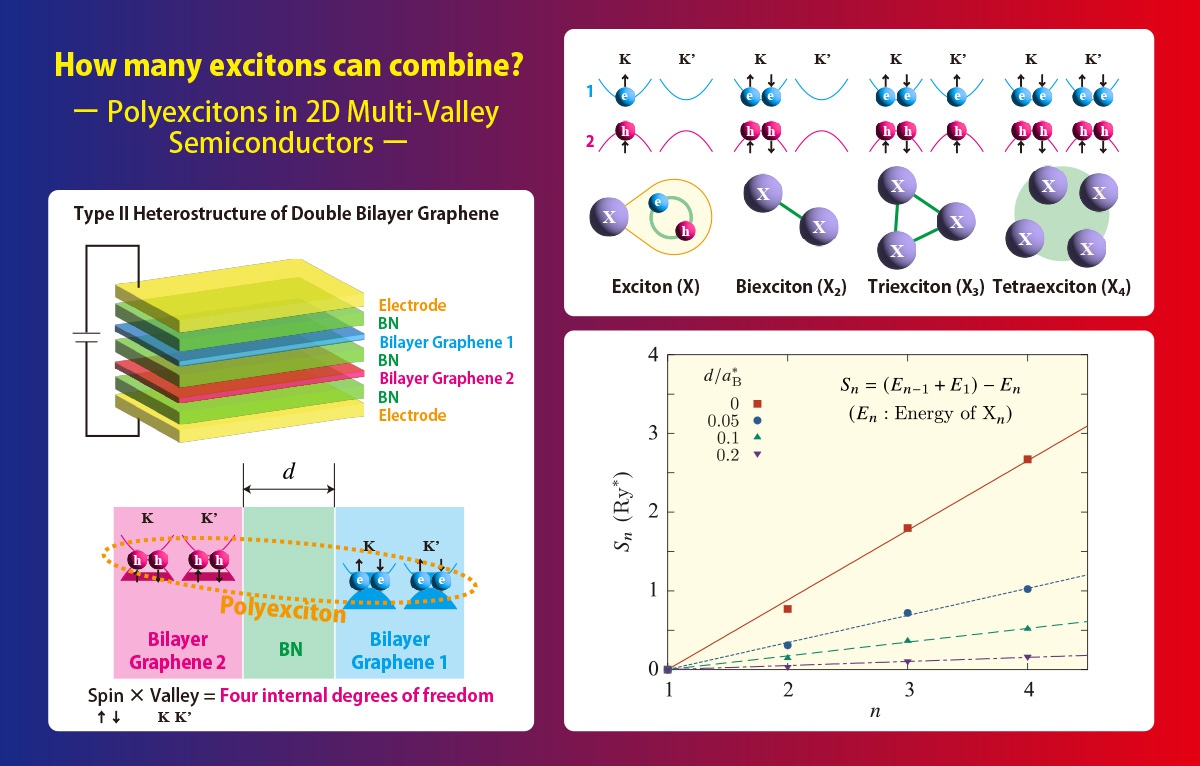How Many Excitons Can Combine?
© The Physical Society of Japan
This article is on
Polyexcitons in Two Dimensions
(JPSJ Editors' Choice)
J. Phys. Soc. Jpn. 92, 073702 (2023).
Quantum diffusion Monte Carlo simulation demonstrated the formation of polyexcitons in two-dimensional multi-valley semiconductor systems, where all exciton pairs were energetically bound by equal-strength “chemical bonds.”

Polyexcitons are composites of multiple electron-hole pairs. In strongly photoexcited intrinsic semiconductors or type II semiconductor heterostructures, an electron in conduction bands and a hole in valence bands naturally form an exciton, and further, a pair of excitons coalesces into a biexciton. These composites have been studied in an analogy to hydrogen atoms or molecules. A common expectation is that excitons cannot form triexcitons, similar to hydrogen atoms that cannot form trimers. However, in multi-valley semiconductors, more than two excitons can be bound, because electrons and holes acquire the additional valley degrees of freedom that, combined with the spins, allow more than two electrons and holes to occupy the same position. This possibility was first identified by Wang and Kittel in 1972 and has been experimentally observed in pure bulk samples of silicon and diamond as the photoluminescence (PL) peaks almost equally spaced at energy intervals.
We consider the two-dimensional simplified model of the type II double-bilayer graphene heterostructures. The electrons and holes stay on different layers separated by a distance and interact with each other via Coulomb potentials. They also acquire four internal degrees of freedom because they have two spin and two valley degrees of freedom. This implies that our system can afford triexcitons and tetraexcitons, and that the quantum diffusion Monte Carlo simulation is free of the negative sign problem and can precisely evaluate the energies.
Notably, the separation energy required to pull out one exciton from the polyexciton grows almost exactly linearly with the exciton number. This behavior resembles the aforementioned PL peaks, indicating that the underlying physics is common between two and three dimensions. This further implies that all pairs of excitons inside the polyexciton are energetically bound by “chemical bonds” of equal strength, irrespective of the bound exciton numbers or the details of the system, for example, the interlayer distances.
(Written by K. Asano on behalf of all the authors)
Polyexcitons in Two Dimensions
(JPSJ Editors' Choice)
J. Phys. Soc. Jpn. 92, 073702 (2023).
Share this topic
Fields
Related Articles
-
Antiferromagnetism Induces Dissipationless Transverse Conductivity
Electronic transport in condensed matter
Magnetic properties in condensed matter
Electronic structure and electrical properties of surfaces and nanostructures
2024-7-24
An investigation using high-quality NbMnP crystals demonstrates that the anomalous Hall conductivity arising from antiferromagnetism is dissipationless, as expected from the intrinsic mechanism.
-
d2 Trimer and d3 Tetramer in a Pyrochlore Lattice
Dielectric, optical, and other properties in condensed matter
Electron states in condensed matter
2024-7-11
Based on the charge disproportionation of V3+ and V2+, the V3+(d2) trimers and V2+(d3) tetramers in the vanadium pyrochlore lattice of AlV2O4 are described by the orbitally-induced Peierls mechanism.
-
Structural Rotation and Falsely Chiral Antiferromagnetism: A New Combination Generating Ferrotoroidic State
Magnetic properties in condensed matter
Dielectric, optical, and other properties in condensed matter
2024-7-4
The ferrotoroidic state, an exotic state of matter with broken space inversion and time-reversal symmetries, was achieved by combining structural rotation and falsely chiral antiferromagnetism in PbMn2Ni6Te3O18.
-
Current Melt Frozen Electrons
Dielectric, optical, and other properties in condensed matter
Magnetic properties in condensed matter
2024-1-15
The origin of the current-induced insulator-to-metal transition of samarium monosulfide was explained by the 4f−5d hybridization observed using optical reflectivity and photoelectron spectroscopies.
-
Towards Uncovering the Hidden Order of URu2Si2 Phase Transition
Magnetic properties in condensed matter
Electronic structure and electrical properties of surfaces and nanostructures
2024-1-11
We propose a chiral charge as the hidden order parameter in URu2Si2 and present experiments to detect it by focusing on breakings of mirror and inversion symmetries at the local uranium ion.
